Types of Florida Oak Trees with Their Bark and Leaves – Identification Guide (Pictures)
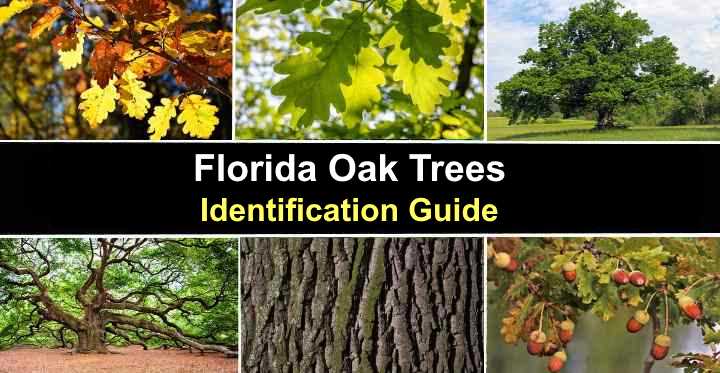
Oak trees in Florida are an important part of the landscape. Many oak trees are native to Florida and grow throughout the Sunshine State. From the evergreen southern live oak trees that thrive in South Florida to the deciduous oak trees like the Shumard oak and willow oak in the north, you will find a wide variety of oak tree species.
Florida’s oak trees are some of the most beautiful and majestic trees growing in the state. The oak trees are identified by their vast, spreading crowns, thick trunks covered in rough, gray bark, leathery leaves, and acorns in varying shapes and sizes. Florida is home to many species of white oaks, red oaks, and the southern live oak tree.
This article is a guide to identifying the most common oak trees growing in Florida. Descriptions and pictures of oak trees in Florida’s landscape will help you recognize these stately deciduous and evergreen trees.
Florida Oak Tree Facts
Oak trees are flowering trees or large shrubs in the genus Quercus. Many species of oak trees are identified by their characteristic obovate or oblong leaves with deeply lobed margins. However, some species of oaks in Florida have leaves without lobes that look like willow or laurel leaves.
There are over 450 species of oak trees, 19 of which are native to Florida. The impressive large trees have an identifiable rounded or pyramidal crown, brown or black nuts in a warty cap, and leaves that grow spirally on woody branches.
Oak tree fruits are oval acorns with rounded or pointed tips. The smooth light brown to dark brown nuts sit in a scaly cap called a cupule. Mature oak trees only start producing acorns after growing for 20 to 30 years.
Common oak trees in Florida are divided into three categories — two are deciduous, and one is evergreen. Deciduous Florida oak trees are in the red oak and white oak groups. The live oak is a type of white oak, but it’s an evergreen Florida oak tree.
White and red oaks are generally found north of Orlando and Tampa, as well as in Florida’s panhandle. In addition, southern live oaks are found throughout Florida — from Miami and the Florida Keys in the South to Jacksonville and Tallahassee in Northern Florida.
Native Florida oak trees thrive in full sun and withstand the humid conditions in the state. Oaks suitable for northern Florida grow in USDA zones 5 to 9. However, some oaks are only cold-hardy in zones 9 and 10 and only grow south of Orlando.
Florida’s oak trees are famous for their tall stature with densely growing foliage that provides plenty of shade. Oak trees in Florida can grow between 60 and 100 ft. (18 – 30 m) tall and up to 135 ft. (41 m) wide.
Florida White Oak Tree
Florida white oak trees have smooth, obovate leathery leaves with rounded tips and lobes around the margins. The lobed tips don’t have the characteristic bristles of some red oak leaves. White oak acorns mature in six months and have a sweet or slightly bitter taste after leeching the tannins.
White oak trees in Florida typically grow 50 to 80 ft. (15 – 24 m) tall and wide.
Florida Red Oak Trees
Florida red oak trees are identified by their deciduous lobed leaves with bristled, pointed tips. Unlike white oaks, acorns growing on red oaks take two growing seasons to mature. The brown oval nuts have a very bitter and unpleasant taste. Red oaks in Florida typically grow 60 to 75 ft. (18 – 22 m) high and up to 45 ft. (13 m) wide.
Florida Live Oak Trees
Florida live oaks are evergreen trees, identified by their gnarled, horizontally growing branches and spreading, open crown. Live oaks have smooth, dark-green glossy, oblong leaves and small egg-shaped dark-colored acorns. The most common live oak species in Florida is the southern live oak, with its identifiable draping of Spanish moss hanging from branches.
In Florida, live oak trees typically grow up to 66 ft. (20 m) tall and 90 ft. (27 m) wide.
Florida Oak Tree Bark
Florida oak trees have smooth, silvery-brown bark when the tree is young. The bark develops deep grooves and raised ridges as the tree matures, giving a rough, fissured appearance and feel. Bark on Florida white oaks is typically light gray, and red oaks have dark, almost black bark.
Florida Oak Tree Leaves
The oak leaf shape and lobed margins help identify individual species of Florida oak trees. For example, white oaks have characteristic leaves with a broad, rounded apex and deep rounded lobes along the margins. Most red oak varieties have pointed lobes with bristled tips. In contrast, southern live oaks have smooth, thick leathery leaves.
Florida Oak Tree Acorns
Acorns on Florida oak trees are egg or barrel-shaped brown nuts growing in warty caps that are sometimes hairy. The oak tree acorns can be light tan to dark brown in color. The difference in shape is that some oak species have rounded oval acorns, and others have pointed almost triangular-shaped nuts.
Florida Oak Tree Flowers
Flowers on oak trees growing in Florida are slender yellowish-green stems with small clusters of flowers. The dangling male oak catkins differ from the female flowers that grow on the same tree. Female oak tree flowers are tiny reddish clusters growing on short stems. Oak flowers are described as inconspicuous.
Florida Oak Tree Identification
Identifying an oak tree in a Florida landscape is by its leaf shape, size and shape of the acorns, and type of bark. Its gray color and deep fissures identify oak tree bark. Leaves of deciduous oak trees have deep lobes, and some have bristled tips. Acorns are shades of brown and generally oval.
Types of Florida Oak Trees (With Pictures)
Let’s look in detail at the most common oak trees in Florida.
Types of Florida White Oak Trees
Eastern White Oak (Quercus alba)
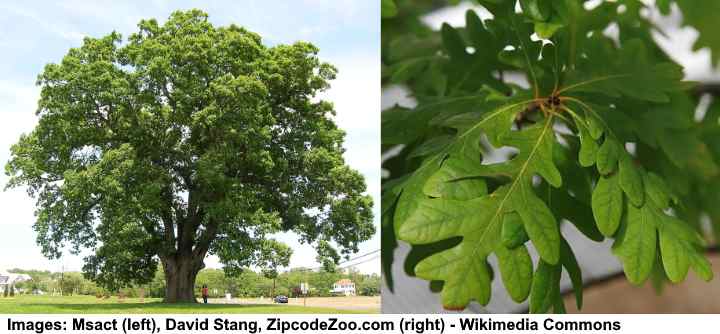
Eastern white oak tree and its leaves
The eastern white oak is found in northwest Florida and grows 80 – 100 ft. (24 – 30 m) tall. This Florida oak is identified by its horizontal lower branches and spreading, broadly rounded crown. White oak acorns are light brown with a rounded apex and scaly brown cap.
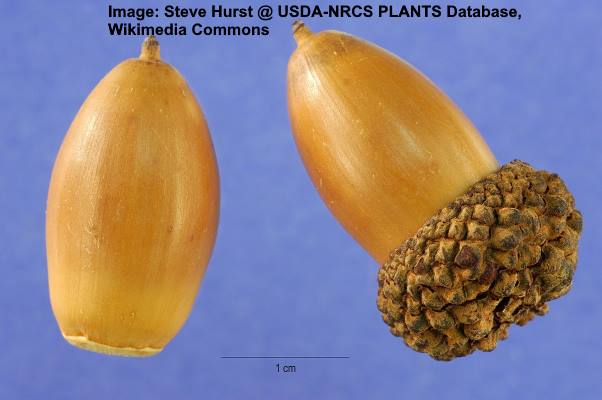
White oak acorns
Florida oak tree bark: Eastern white oak bark is light gray with an irregular scaly pattern and vertical fissures.
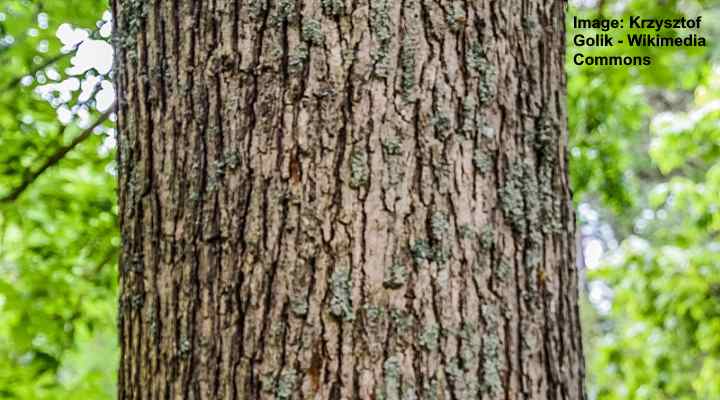
Eastern white oak bark
Florida oak tree leaves: Eastern white oak tree leaves are obovate with seven to nine lobes on the margin and measure 9” (23 cm) long and 4” (10 cm) broad. The glossy dark green leaves turn spectacular deep red colors in the fall.
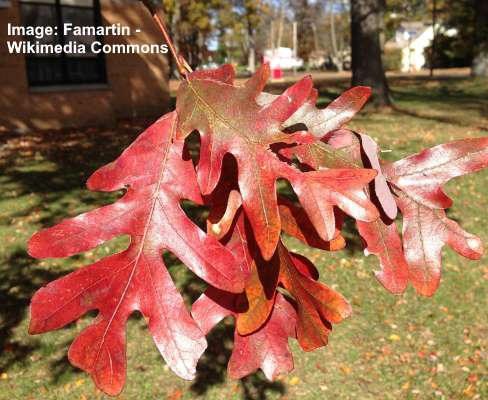
White oak leaves in autumn
Post Oak (Quercus stellata)
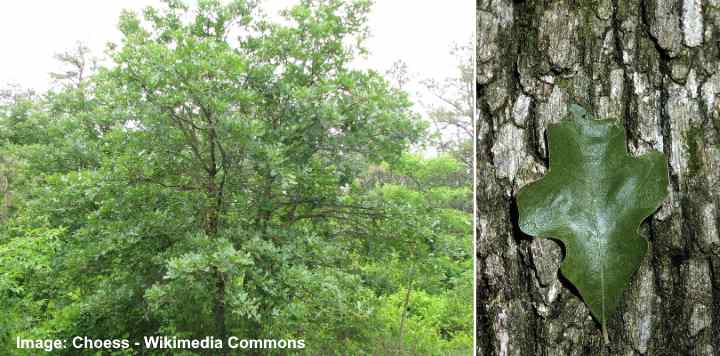
Post oak tree, bark and leaves
The post oak tree is a native deciduous tree growing in central and northern Florida. The stately post oak tree grows 40 to 50 ft. (12 – 15 m) tall and is identified by its irregular rounded crown. The round, oval brown nuts measure between 0.5 and 1” (1.3 – 2.5 cm) long.
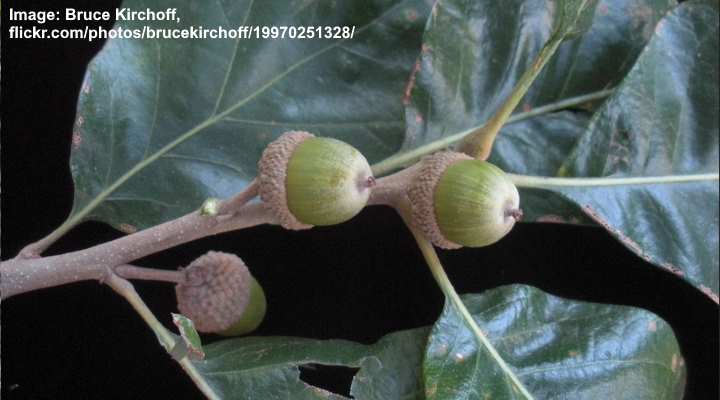
Immature post oak acorns
Florida oak tree bark: Post oak tree bark has characteristic light gray ridges with horizontal cross breaks, creating a rough texture.
Florida oak tree leaves: Post oak tree leaves have deep lobes, giving them the appearance of a Maltese cross. The oak leaves measure 8” (20 cm) long and turn a dull copper color in the fall.
Sand Post Oak (Quercus margarettae)
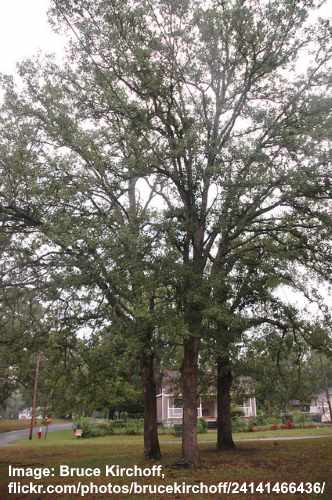
Sand post oak trees
The sand post oak tree is a small oak that grows around 40 ft. (12 m) tall and thrives in sandy soil. The large shrub-like tree has an identifiable dense, rounded crown with gnarled and twisted branches. The oak tree produces globe-shaped acorns growing in groups of one to three nuts.
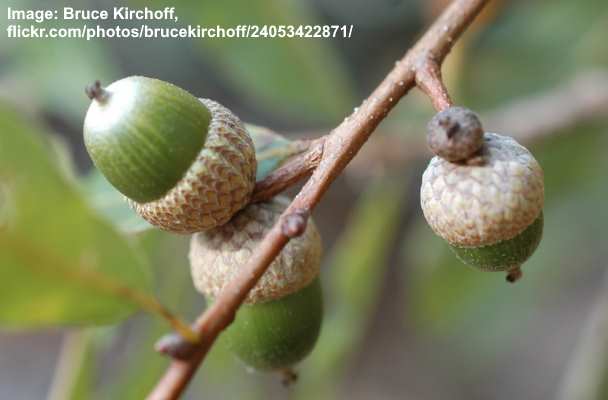
Sand post oak acorns
Florida oak tree bark: Sand post oak bark is light gray with shallow fissures and scaly ridges.
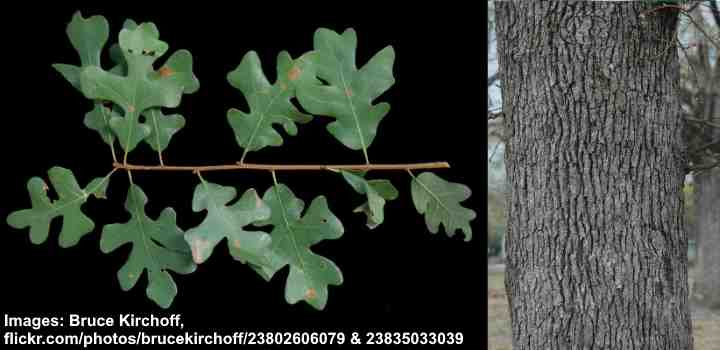
Sand post oak leaves and bark
Florida oak tree leaves: Sand post oak leaves are broadly rounded with three to five irregular lobes on the margins. The small oak leaves grow up to 4” (10 cm) long and 2” (5 cm) wide.
Swamp Chestnut Oak (Quercus michauxii)
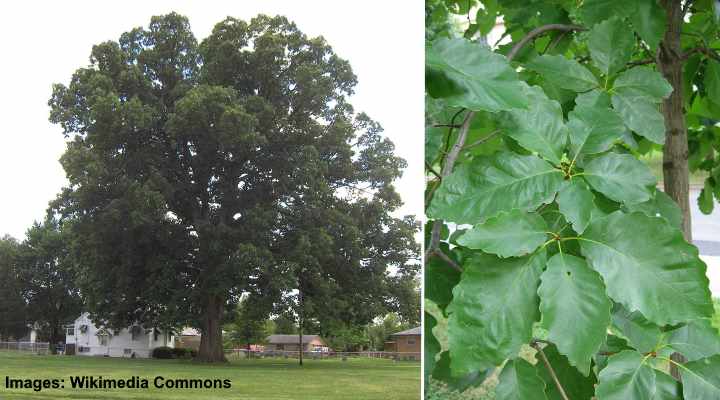
Swamp chestnut oak tree and leaves
The swamp chestnut oak grows in Florida’s zones 6 through 9 and thrives in poorly drained soils and full sun. The tall deciduous swamp chestnut oak tree is identified by its thin bark that peels in rectangular scales. Additionally, the acorns on this oak tree are small oval nuts in a scaly cup.
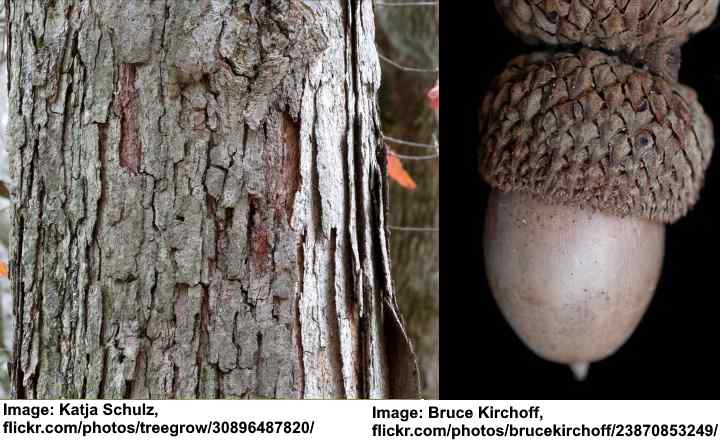
Swamp chestnut oak tree bark and acorn
Florida oak tree bark: The bark of swamp chestnut oak is light to medium gray with flaky ridges and deep V-shaped furrows.
Florida oak tree leaves: Swamp chestnut oak trees have obovate leaves with a shiny green upper side and fuzzy, grayish underside. The fall color of swamp chestnut trees is deep red.
Bur Oak (Quercus macrocarpa)
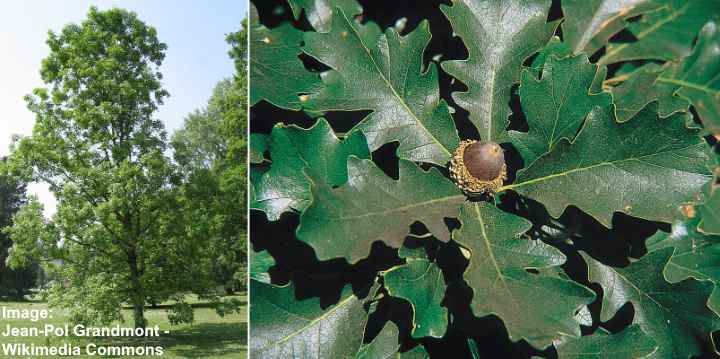
Bur oak tree, leaves and acorn
The bur oak is a vast native Florida oak tree with light brown to gray bark, acorns covered in a furry cap, and large glossy green lobed leaves. This cold-hardy tree thrives in USDA zones 3 to 8 and is found in Florida’s panhandle. Bur oaks grow 70 to 90 ft. (21 – 27 m) tall and up to 80 ft. (25 m) wide.
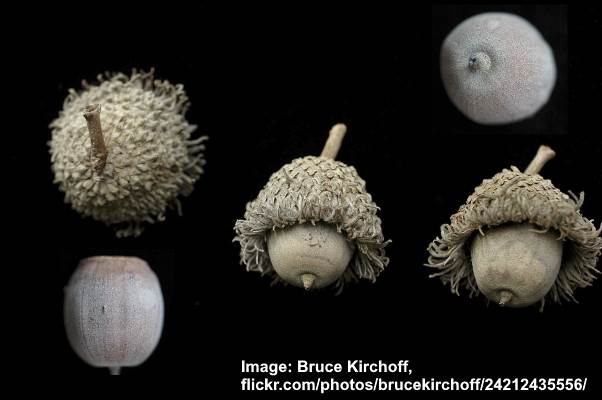
Bur oak acorns
Florida oak tree bark: Bur oak bark is an unusual light brown to gray color that develops deep furrows as the tree matures.
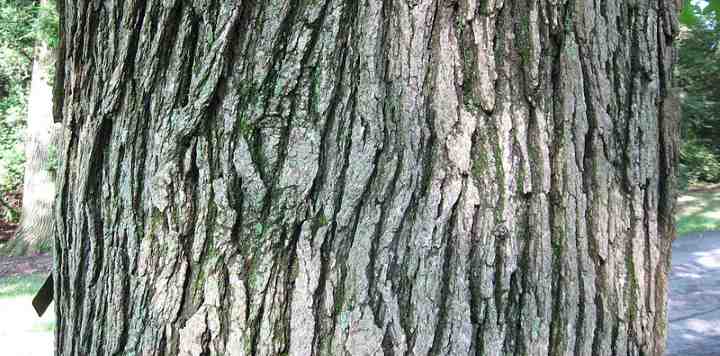
Bur oak bark
Florida oak tree leaves: Bur oak tree leaves are described as leathery, dark green with up to nine irregular lobes that almost reach the central stem. The fall color of bur oaks in Florida is an unimpressive yellow.
Holm Oak (Quercus ilex)
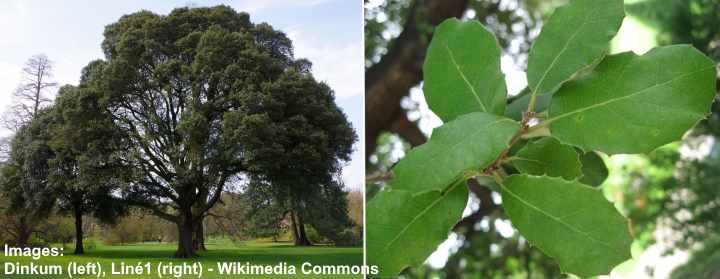
Holm oak tree and leaves
Also called the holly oak, this evergreen oak tree has shiny, dark-green, lance-shaped leaves, brown acorns with a tapered apex, and dangling yellowish-green spring flowers. The oak tree is identified by its dense, rounded crown, and it grows 70 to 92 ft. (21 – 28 m) tall.
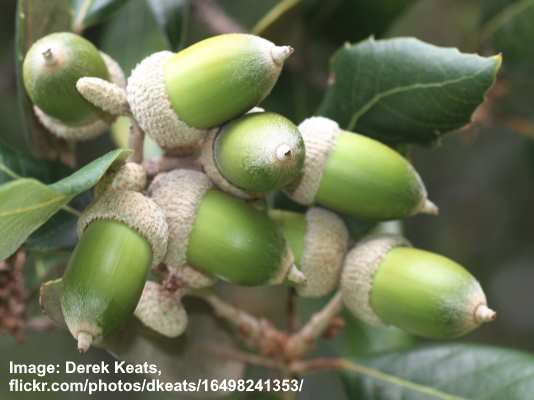
Holm oak acorns
Florida oak tree bark: The distinctive bark of holm oak trees has a cracked appearance and is a gray to black color. This bark type helps identify this oak tree species from other oaks.
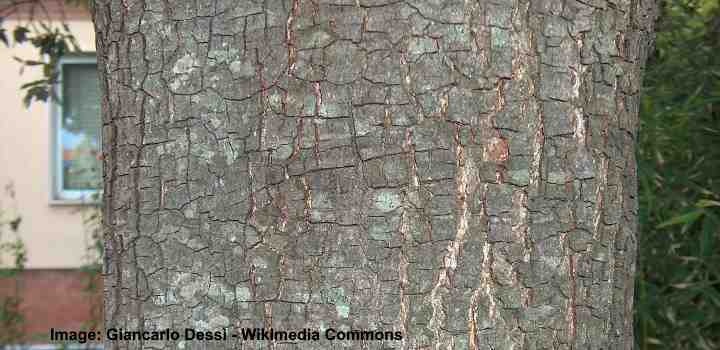
Holm Oak bark
Florida oak tree leaves: The evergreen leaves of the holm oak are oval and taper to a point. Unlike other white oaks, the leaves lack the characteristic lobed margins.
Chinkapin Oak Tree (Quercus muehlenbergii)
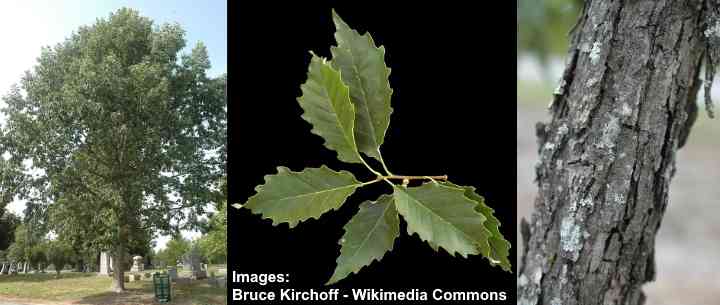
Chinkapin oak tree, leaves and bark
The chinkapin oak tree is a tall species of white oak tree in Florida with a broad, round canopy, bright green lance-shaped leaves, and small, edible acorns. This native oak tree grows throughout central and northern Florida. It will grow 40 to 60 ft. (12 – 18 m) tall and (50 to 70 ft. (15 – 21 m) wide.
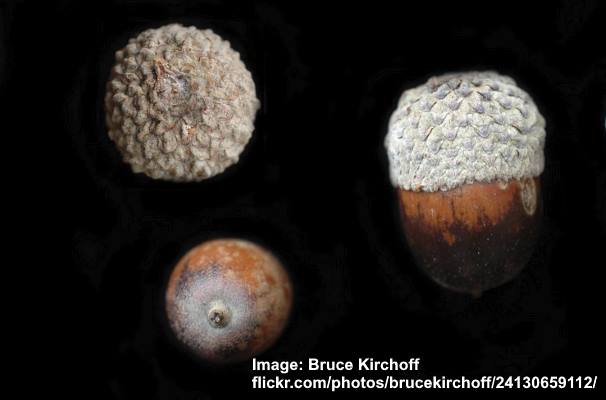
Chinkapin oak acorns
Florida oak tree bark: Chinkapin oak tree bark is gray and flaky with yellowish-brown patches and deep ridges.
Florida oak tree leaves: Chinkapin oak leaves have toothed margins and a lanceolate shape. Leaves grow 4” to 8” (10 to 20 cm) long and turn yellow in the fall.
Types of Florida Red Oak Trees
Black Oak Tree (Quercus velutina)
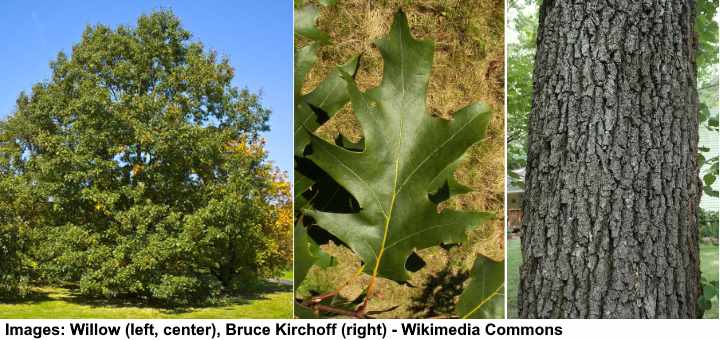
Black oak tree, leaf and bark
The black oak tree grows in the northern regions of Florida and reaches a height of 82 ft. (25 m). This tall variety of red oak is identified by its dark gray bark with yellowish inner bark. The oval brown acorns have saucer-shaped cups and glossy dark green foliage.

Black oak acorns
Florida oak tree bark: Black oak tree bark is relatively smooth when young and becomes ridged as it matures, and has a dark gray to black appearance.
Florida oak tree leaves: Black oak tree leaves are dark green blades with deep lobes around the margins. Like most red oak, the lobes have bristle tips. Leaves measure up to 10” (25 cm) long. The black oak tree’s fall color is orange to reddish-brown.
Southern Red Oak (Quercus falcata)
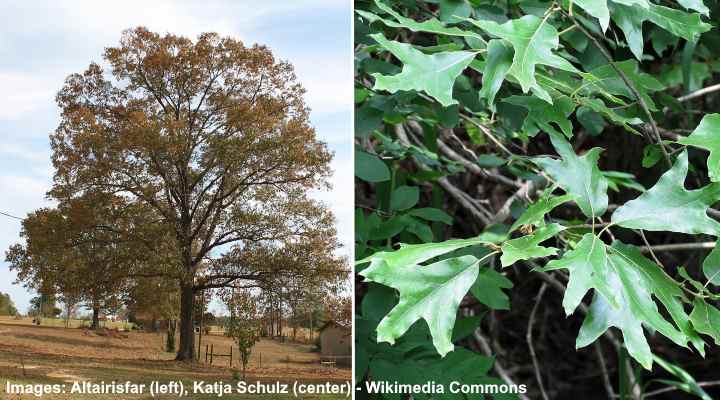
Southern red oak tree and leaves
The southern red oak is a native Florida tree with a straight trunk, rounded oval crown, tan-colored oval acorns, and distinctive pointed leaves. Southern red oak trees grow 80 to 100 ft. (24 – 30 m) tall and have a broad, round-topped crown.
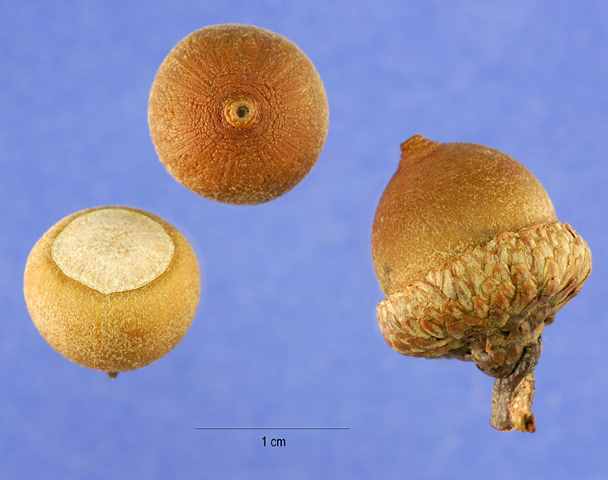
Southern red oak acorns
Florida oak tree bark: Southern red oak tree bark is dark gray to black with vertical ridges and fissures creating irregular patterns.

Southern red oak leaf and bark
Florida oak tree leaves: Southern red oak leaves have three to five long narrow lobes with sharp, bristle-tipped ends. The leaves measure 4” to 12” (10 – 30 cm) long and turn spectacular red in the fall.
Myrtle Oak (Quercus myrtifolia)
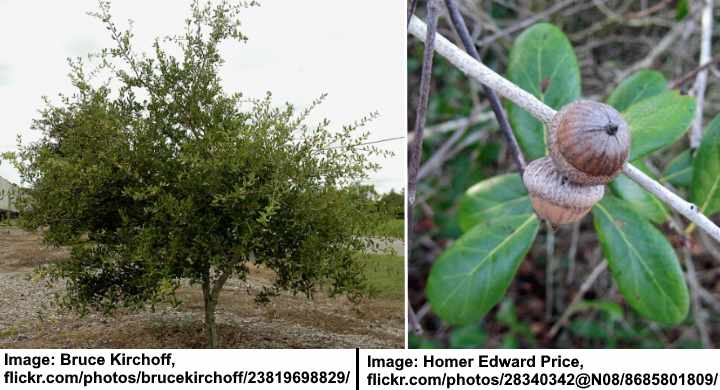
Myrtle oak tree, leaves and acorns
The myrtle oak is a native hardwood tree to the southeastern US that grows extensively throughout Florida. The evergreen oak tree has glossy, leathery leaves in various oval shapes. The tree’s acorns are globose and grow in saucer-shaped cups. The small shrub-like oak trees grow 15 to 20 ft. (4.5 – 6 m) tall.
Florida oak tree bark: Myrtle oak bark is gray to dark brown with deep furrows creating cracks in the trunk.
Florida oak tree leaves: Myrtle oak tree leaves are dark green with a glossy sheen. The oval to obovate leaves have a broadly rounded apex without any lobes along the margins.
Turkey Oak Tree (Quercus laevis)

Turkey oak tree and leaves
The turkey oak is identified by its rounded, spreading crown, dark gray bark, and black acorns sitting in a reddish-brown cap. A distinctive feature of turkey oaks is their lobed narrow leaves that look like a turkey foot. This native oak tree grows 26 to 33 ft. (8 – 10 m) tall and thrives in poor, damp soil.
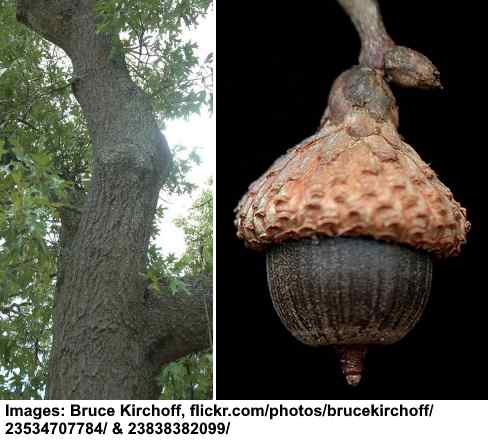
Turkey oak tree bark and acorn
Florida oak tree bark: Turkey oak tree bark has deep furrows and ridges, creating an irregular pattern.
Florida oak tree leaves: Turkey oak tree leaves look like a turkey foot and are a dark green color during summer that turn spectacular oranges and reds in the fall.
Willow Oak Tree (Quercus phellos)
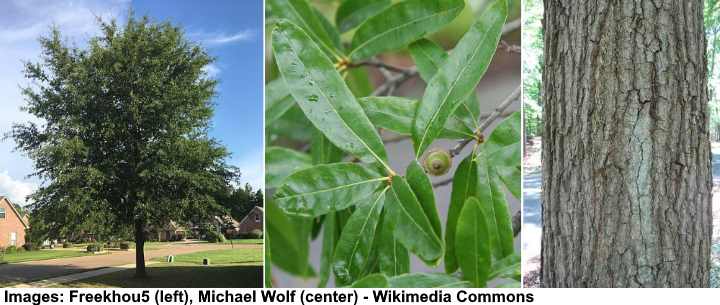
Willow oak tree, leaves and bark
The Florida willow oak tree is a fast-growing deciduous red oak tree with narrow green, bristle-tipped leaves, rounded tan to brown acorns, and a rounded crown. Willow oak trees grow between 65 and 100 ft. (20 – 30 m). The oaks are cold-hardy in zones 5 to 9 and thrive in northern Florida.
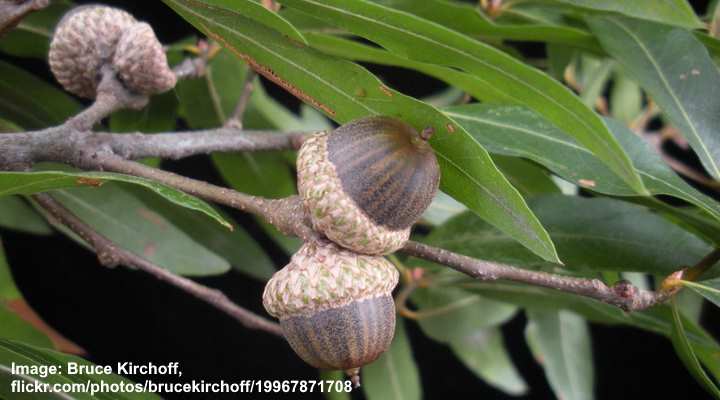
Willow oak acorns
Florida oak tree bark: Willow oak tree bark is smooth and gray on young trees before maturing to form irregular ridges and furrows, creating a rough texture.
Florida oak tree leaves: Willow oak tree leaves are elliptical oblong without lobes on the margins. The distinctive green leaves look like willow leaves, where the oak gets its common name.
Laurel Oak (Quercus laurifolia)
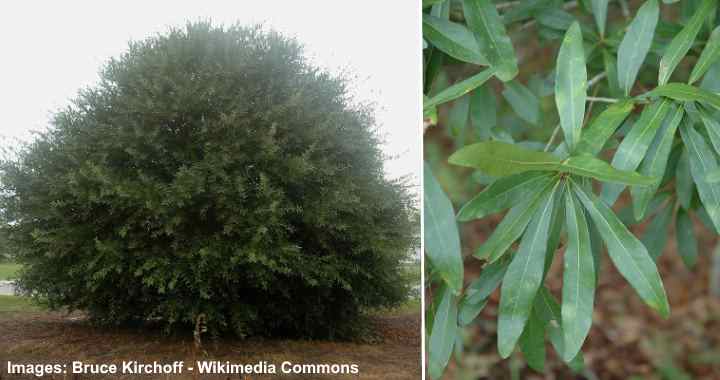
Laurel oak tree and leaves
Laurel oak trees are native to Florida and are semi-evergreen in areas to the south of Fort Myers and West Palm Beach. The tall, fast-growing Florida shade tree thrives in damp soil and has the names water oak and swamp laurel oak tree. The majestic tree grows 65 to 70 ft. (20 -24 m) tall and produces round acorns.
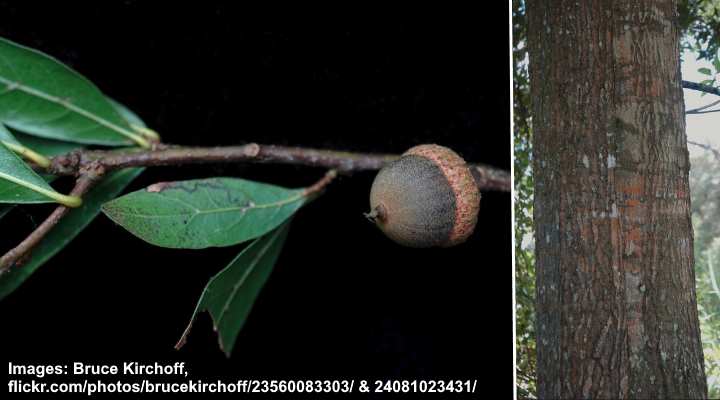
Laurel oak bark and acorn
Florida oak tree bark: Laurel oak tree bark is dark gray and smooth when young, and develops shallow fissures and flat ridges as the tree matures.
Florida oak tree leaves: Laurel oak tree leaves are oblong, oval leaves with a shiny upper and underside. The laurel oak foliage turns coppery-brown in the fall.
Shumard Oak Tree (Quercus shumardii)
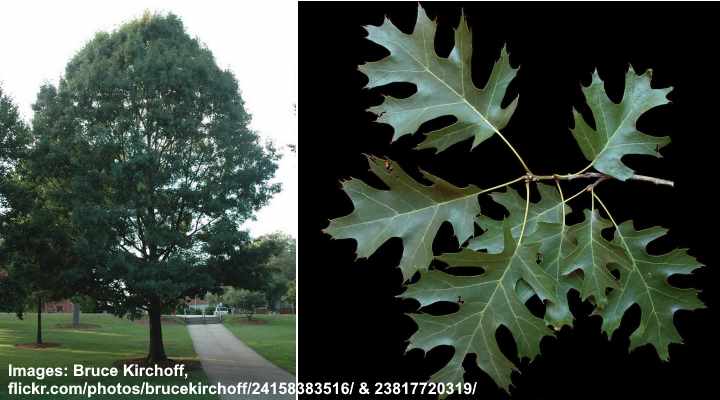
Shumard oak tree and leaves
The Shumard oak tree is a beautiful shade tree that thrives through Florida’s panhandle and south to Orlando. Shumard oaks have an attractive pyramidal crown, bristle-tipped lobed leaves, and a substantial crown. A feature of Shumard oak is that they have the largest acorns of all the oaks — dark-brown acorns measuring up to 1.5” (3.8 cm) wide.
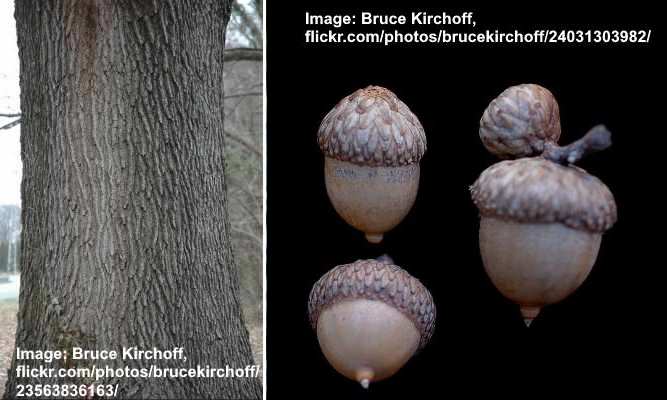
Shumard oak bark and acorns
These native Florida oaks grow 50 to 70 ft. (15 – 21 m) tall and up to 40 ft. (12 m) wide.
Florida oak tree bark: Shumard oak tree bark is dark gray to reddish-brown that develops thick, flat, scaly ridges with shallow grooves as it matures.
Florida oak tree leaves: Shumard oak tree leaves are dark green and have a jagged appearance due to their deep, spiny lobes. The oak leaves measure 6” to 8” (15 – 20 cm) long and turn a spectacular red in the fall.
Types of Florida Live Oak Trees
Southern Live Oak (Quercus virginiana)
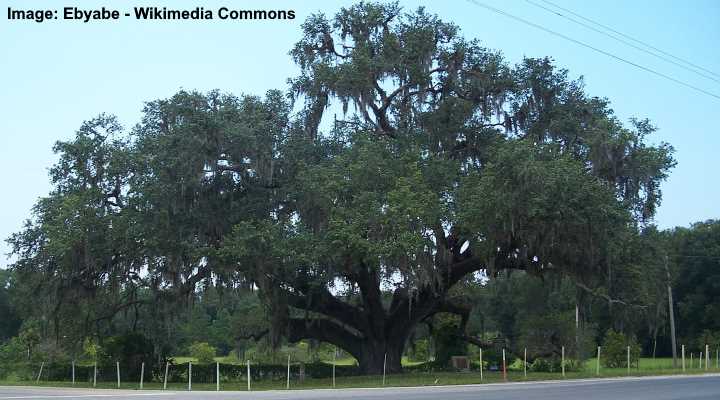
Live oak tree (Quercus virginiana)
The southern live oak is a common Florida oak tree, famous for its vast spreading canopy and gnarled, twisting branches. The identifying features of the southern live oak are its leathery dark-green leaves, thick dark bark, and small egg-shaped dark-brown to black acorns. In Florida, the southern live oak grows 40 to 80 ft. (12 – 24 m) tall and up to 100 ft. (30 m) wide.
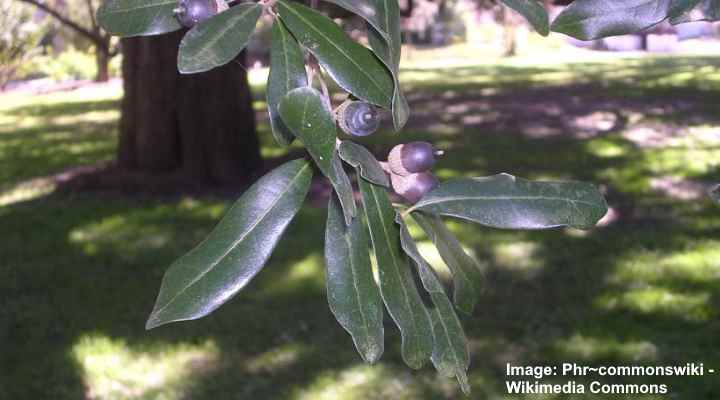
Live oak tree leaves and acorns
Other names for this native Florida evergreen tree include plateau oak, Virginia live oak, bay live oak, and escarpment live oak. However, the tree is so common in the southeastern states that many refer to it as the live oak.
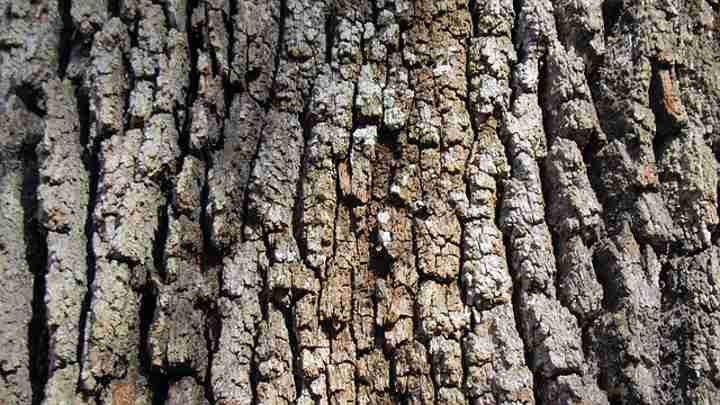
Live oak tree bark
Florida oak tree bark: The southern live oak has dark brown bark with a scaly appearance and longitudinal furrows.
Florida oak tree leaves: Southern live oak leaves are easily recognizable evergreen leaves due to their dark-green appearance, smooth, shiny texture, and pointed tips.
Related articles:
- Types of Oak Acorns – Identification
- White Oak Tree – Identification & Care
- Red Oak Tree – Identification & Care
